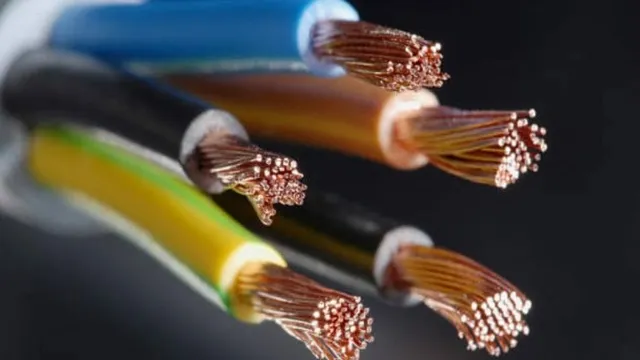When it comes to electrical wiring, choosing the right wire gauge is crucial to ensure safety and proper functioning. If you are planning to install a 20-amp, 220-volt circuit, it is important to understand which wire gauge to choose to avoid any potential hazards. Wire gauge refers to the diameter of the wire, and as the number of the gauge increases, the diameter decreases.
With a 20-amp, 220-volt circuit, you would need a wire that can handle the high voltage and current without overheating or causing electrical fires. Choosing the right wire gauge also depends on the length of the circuit and the type of insulation used. This is because a longer circuit requires a thicker wire to minimize voltage drop, and certain insulation can handle higher temperatures better than others.
In this blog, we will guide you through the process of selecting the right wire gauge for your 20-amp, 220-volt circuit. We will explain the technical aspects of wire gauge and provide practical tips to help you make an informed decision. So, whether you are a DIY enthusiast or a professional electrician, keep reading to learn more!
Understanding Wire Gauge
Choosing the right wire gauge can make the difference between a safely functioning electrical system and a potential hazard. When it comes to a 20 amp 220v circuit, selecting the right wire gauge is critical. The recommended wire gauge for this type of circuit is typically 12 or 10 gauge wire.
However, the selection of the wire gauge should depend on the wire length and the materials being installed. For example, if the wire length is over 100 feet, a larger wire gauge may be necessary to avoid voltage drop. It’s always best to consult with a licensed electrician to ensure the proper wire gauge is chosen for your specific installation.
By taking into account the factors that influence wire gauge selection, you can ensure that your electrical system is safe and reliable.
Wire Gauge and Amps
When it comes to electrical wiring, wire gauge is an important factor to consider. The wire gauge refers to the size and thickness of the wire and is measured in American Wire Gauge (AWG). The lower the wire gauge number, the thicker the wire.
It’s important to choose the correct wire gauge for your circuit to prevent overheating and potential hazards. The wire gauge also affects the amount of current (amps) that can safely travel through the wire. As a general rule, the larger the wire gauge, the more amps it can handle.
For example, a 12-gauge wire can carry more amps than a 16-gauge wire. Knowing the wire gauge and amps that your circuit requires can ensure that your electrical system operates safely and efficiently. So, be sure to choose the appropriate wire gauge for your electrical project to avoid any potential safety risks or damage to your system.

Wire Gauge and Voltage
If you’re working on an electronics project, understanding wire gauge is a crucial aspect of ensuring the safety and efficiency of your circuit. The gauge of a wire refers to its diameter, with smaller numbers representing thicker wires. Choosing the wrong wire gauge can result in a host of problems, from overheating to electrical fires.
To determine the appropriate gauge for your project, you need to consider several factors, including the voltage running through the wire and the length of the circuit. Keep in mind that the longer the wire, the greater the resistance, which means you need a thicker wire to handle the voltage. Choosing the appropriate wire gauge can ensure that your project runs safely and efficiently, so be sure to do your research before getting started.
Calculating Wire Gauge for 20 Amp 220V
When it comes to determining what gauge wire to use for a 20 amp 220V circuit, there are a few factors to consider. One important consideration is the length of the wire run, as longer runs may require thicker wire to prevent voltage drop. It’s also important to check the ampacity rating of the wire, which indicates the maximum amount of current the wire can safely carry without overheating.
For a 20 amp circuit, you’ll want to select wire with an ampacity rating of at least 20 amps. In terms of wire gauge, a 12-gauge wire is a common choice for 20 amp circuits, though a 10-gauge wire may be necessary for longer runs. It’s important to always follow local codes and regulations, and consult with an electrician if you have any doubts or questions.
By selecting the right wire gauge for your 20 amp 220V circuit, you can ensure safe and efficient operation of your electrical system.
Step 1: Determine Distance
When it comes to calculating wire gauge for a 20 Amp 220V circuit, the first step is to determine the distance of the wiring run. The distance refers to the length of the wire from the power source to the load. Longer distances require thicker wires to reduce resistance and prevent voltage drops.
This is important because voltage drops reduce the efficiency of appliances and can lead to equipment damage. You can use a wire gauge chart to calculate the minimum wire size needed for any distance and amperage. To make sure your wire is rated for 220V, look for wire marked “600V” or “1000V.
” This ensures that the wire is rated for the higher voltage and will be safe to use. Once you have determined the distance and wire size, it’s time to move on to selecting the appropriate conduit size and installing the wiring. By following these steps, you can ensure a safe and efficient electrical installation.
Step 2: Find Voltage Drop Allowance
When calculating the wire gauge for a 20 amp 220V circuit, the next step is to determine the voltage drop allowance. This is important because voltage drops can lead to inefficiencies and even pose safety hazards. To calculate the voltage drop allowance, one must consider the distance between the source and the load, the wire material and gauge, and the current load.
As a general rule, the voltage drop should be limited to 3% or less for power circuits. This means that for a 220V circuit, the voltage drop allowance should not exceed 6V.
With this information in mind, one can select the appropriate wire gauge that can handle the current load without exceeding the voltage drop allowance. By doing so, you can ensure that your electrical circuit operates safely and efficiently without any voltage drops that can cause potential damage.
Step 3: Select Correct Wire Gauge
When it comes to selecting the correct wire gauge for a 20 Amp 220V circuit, it’s essential to consider the distance between the power source and the appliance, the type of appliance, and the expected load. The wire gauge determines the maximum amount of current that can flow through the circuit without overheating. As a general rule of thumb, the distance between the source and the load should be no more than 100 feet for 20 Amps.
To ensure safety, the wire gauge should be sized according to the National Electric Code (NEC) standards. For a 20 Amp 220V circuit, the appropriate wire gauge would be 12 or 10 AWG for copper wire, or 8 AWG for aluminum wire. Choosing a wire gauge that is too small can result in overheating or a tripped breaker, while selecting a gauge that is too large can be unnecessary and expensive.
Properly sizing the wire gauge for a 20 Amp 220V circuit can help ensure safe and efficient electrical operation.
Recommended Wire Gauge for 20 Amp 220V
If you are wondering what gauge wire to use for a 20 amp 220v circuit, the answer is typically a #12 wire. However, it’s essential to consider the distance the wire will have to travel and the number of amps you’ll be using. If you’re going to use the full 20 amps of power over a distance of around 25 feet, a #10 wire would be more appropriate to use.
It’s vital to ensure that your wire’s thickness is sufficient for the amount of power you will be drawing through it, as smaller wires can quickly become overwhelmed and present a safety risk. Additionally, it’s critical to use wire that is rated for 220 volts to ensure the wire and any connected devices are safe and function correctly. Remember, when it comes to electrical work, safety should always be your top priority, so don’t hesitate to seek professional advice if you’re unsure.
Copper Wire vs. Aluminum Wire
When it comes to wiring a 20-amp 220V electrical circuit, the recommended wire gauge is typically between 10 and 12, depending on the length of the circuit and the type of wiring used. But what type of wiring should you use, copper or aluminum? While both materials have their advantages and disadvantages, copper wire is generally considered the better option for higher load circuits such as a 20-amp 220V circuit. Copper is a better conductor of electricity than aluminum, which means that it can handle higher levels of electrical current without overheating or becoming damaged.
Additionally, copper wire is more ductile and less prone to oxidation and corrosion than aluminum wire, making it less likely to break or become damaged over time. Overall, if you want to ensure a safe and reliable electrical circuit, it’s best to use copper wire for your 20-amp 220V circuit.
Wire Gauge Chart for 20 Amp 220V
If you’re working on a DIY electrical project that requires a 20 Amp 220V circuit, you need to make sure that you’re using the right wire gauge. Using the wrong wire gauge can lead to safety hazards and harm the equipment you’re using. The recommended wire gauge for a 20 Amp 220V circuit is 12 AWG copper wire.
This wire gauge can handle up to 20 Amps of current and is easily available at most hardware stores. When selecting your wire, pay attention to the insulation on the wire as well. It should be rated for at least 300V to ensure it can handle the voltage of a 220V circuit.
It’s important to note that wire gauge can vary depending on the length of the wire and the specific application, so refer to a wire gauge chart or consult with a professional electrician if you’re not sure what wire gauge to use. Remember, safety should always be your top priority when working with electricity.
Conclusion
As we come to the end of our wire gauging journey, it’s clear that selecting the right gauge wire for a 20 amp 220v circuit is crucial. It’s not just about preventing power loss or avoiding wire overheating, but also keeping electrical safety in mind. So, whether you’re a DIY enthusiast, an electrician, or just a curious observer, remember to always consult the relevant codes and standards, use a wire gauge chart, and never underestimate the power of proper wire selection.
With the right wire in place, you can 220v-olt into action with confidence and peace of mind. (See what we did there?)
FAQs
What is the recommended wire gauge for a 20 amp 220v circuit?
The recommended wire gauge for a 20 amp 220v circuit is typically 12 AWG.
Can I use a lower gauge wire for a 20 amp 220v circuit?
No, it is not recommended to use a lower gauge wire for a 20 amp 220v circuit as it can cause overheating and potentially start a fire.
Is it safe to use a higher gauge wire for a 20 amp 220v circuit?
Yes, it is safe to use a higher gauge wire for a 20 amp 220v circuit, but it may not be necessary and can be more expensive.
What are the consequences of using the wrong wire gauge for a 20 amp 220v circuit?
Using the wrong wire gauge for a 20 amp 220v circuit can cause overheating, potentially leading to a fire or damage to equipment.
Can I use aluminum wire for a 20 amp 220v circuit?
Yes, aluminum wire can be used for a 20 amp 220v circuit, but it must be sized properly and installed correctly to avoid issues.
How far can I run a 20 amp 220v circuit with 12 gauge wire?
The maximum recommended distance for a 20 amp 220v circuit with 12 gauge wire is approximately 50 feet.
Can I use a 3-prong plug for a 20 amp 220v circuit?
No, a 3-prong plug is not recommended for a 20 amp 220v circuit as it requires a 4-prong receptacle for safety and compliance with electrical codes.






